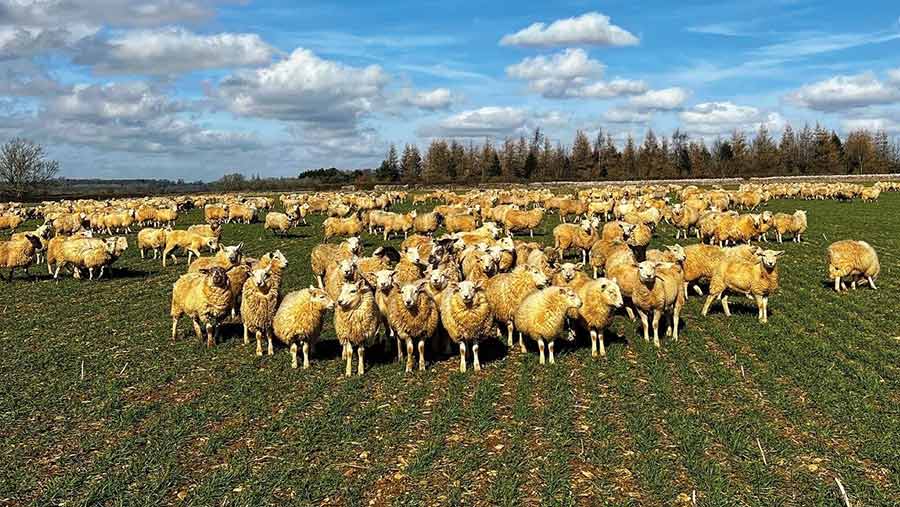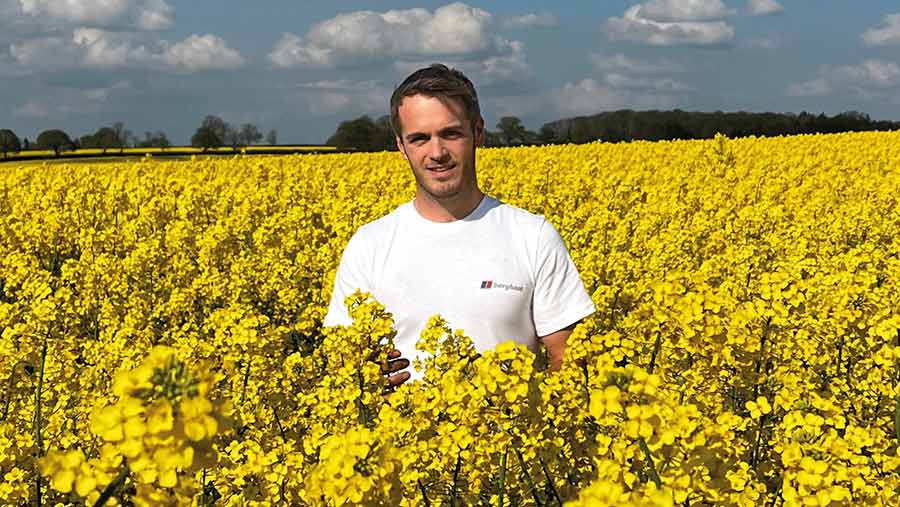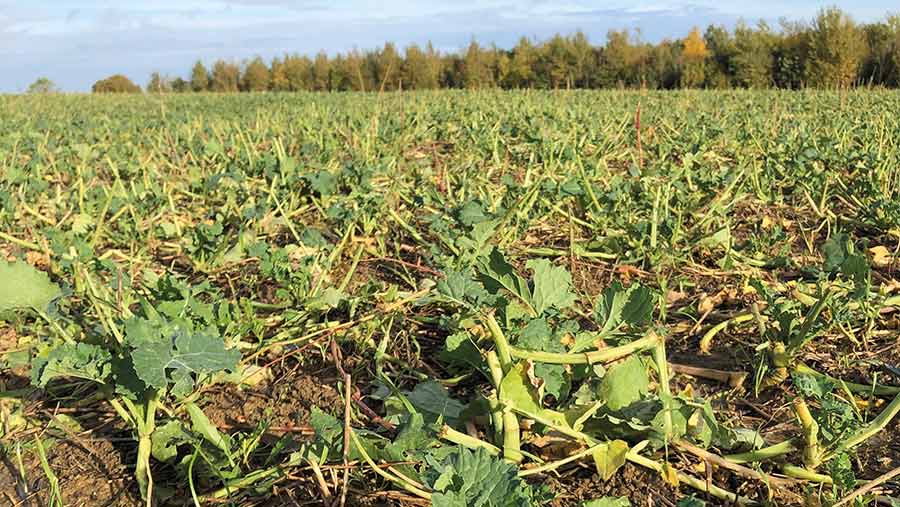Farmer grazes 2,500 sheep on cereal crops for disease control
 © Ed Horton
© Ed Horton Cotswold mixed farmer Ed Horton grazed 2,500 sheep on nothing but cereals and oilseed rape from December to March as part of his low-input arable system.
Strategic sheep grazing is Mr Horton’s number-one disease management tool.
Whether crops are a group 3 McVitie’s biscuit wheat or an ancient spelt grain, the integrated approach has slashed production costs but maintained yields.
See also: Shallower potato cultivation depths recommended in wet season
Wheat, barley, rye, spelt, triticale, oats and oilseed rape all took a graze this winter, largely eliminating fungicide and completely eradicating plant growth regulators across 1,600ha.
The ‘golden hoof’
This season’s disease management began in November, when a mob of 750 hungry lambs were turned out to a block of winter barley.
The sheep removed the leaves infected with net blotch and rynchosporium, before producing fresh new leaves with no latent disease.
“Grazing the lamb mob for two-and-a-half weeks saved an autumn fungicide and a T0 spray and PGR application on the winter barley, which would have cost about £48/ha.
“It also controlled barley yellow dwarf virus by removing aphid populations before they could infect plants,” says Mr Horton.
After grazing the winter barley, the mob were moved to a block of stubble turnips, before beginning the main cereal grazing season from December to early spring.
Grazing arable crops with sheep was once a traditional sight across many farms in the UK.
Before the arrival of the artificial chemical boom, which began in the early 1950s, the “golden hoof” provided an effective way to sustainably manage crops to produce a better return.

© Ed Horton
Mr Horton explains that his hybrid sheep and arable system has been in place for nine years on his light Cotswold brash soils.
Over this time, it has significantly reduced, or in some cases completely removed, herbicides, fungicides and growth regulators requirements.
“The sheep effectively remove overwinter disease, cycle nutrients and stimulate more tillering.
“The golden hoof is starting to make a comeback, under trendy taglines such as ‘regenerative’ and ‘agroecological’ – but call it whatever swanky name you like, it’s already been done before.
“We just need to relearn the knowledge that was sadly lost over time with the invasion of multinational corporations who looked to monetise the sector,” he says.
Benefits of grazing arable crops
- Fungicide cutbacks Fungicide spend on wheats have been cut back to just £45/ha on average. In fact, last year zero fungicides were applied to wheat crops as disease pressure was low. Although, Mr Horton admits yields were below average thanks to the yield-limiting nature of Cotswold Brash soils.
- Weed control One year, a field of oats had an influx of sterile brome, which Mr Horton grazed hard as a sacrificial crop to remove the weed. The oats performed like he never imagined, with his highest-ever oat yield, averaging 7.5t/ha. “We used no plant growth regulators, no herbicides, no fungicides and just a small application of nitrogen.”
- Uniform tillers Post-grazing, tillers evenly develop, which eliminates the requirement for plant growth regulators as all tillers are at an equal growth stage. “In a split block of land where half the cereals were grazed, three even-sized tillers developed post-grazing compared to one main tiller with two unequal smaller tillers where we hadn’t grazed sheep.”
- Greater root biomass Removing above-ground biomass via grazing shocks cereal crops into building larger root systems. “After the initial stress, crops focus their energy reserves into building root biomass. We have seen roots twice the size as conventionally grown crops.” This means better water availability and nutrient uptake, particularly in times of drought.
- Improved soil interactions Crops actively interact with soil microorganisms and take up nutrients naturally occurring in the soil as roots burrow deeper, rather than being “reliant on food sources fed from machines above,” explains Mr Horton. “This enables a natural symbiotic relationship as root fungal hyphae interact with the soil. We see this through large root systems, binding strongly to soil with increased levels of glomalin – a glycoprotein produced on root hyphae.”
- Improved nutrient cycling Sheep encourage better nutrient cycling as N initially in the canopy is put back into the land via manure to feed the plant as it regrows. Furthermore, Mr Horton uses home-saved seed treated solely with trace elements. He specifically includes magnesium and manganese, which are otherwise locked up in his calcareous limestone soils for improved crop performance. Fungicide-treated seed dressings are not used due to the negative impacts between soil fungi and young seedlings.
- Reduced pests The build-up of both cereals and oilseed pests, including cabbage stem flea beetle, are minimised as the host crop is removed and pests are physically damaged by grazing.
Strategic grazing
Mr Horton works closely with neighbouring shepherd Howard Ford who runs an extensive grazing system.
The pair strategically plan the grazing platform about six months in advance according to crop type, variety and, of course, the weather.
“It’s a very thought-out process and not just a case of throwing a load of sheep into a field and letting them get on with it.
“Howard uses three strands of electric wire and we always fence at least two blocks ahead in case the weather makes a turn for worse and we need to quickly move fields to avoid poaching.”
Oilseed rape
Grazing sheep on oilseed rape successfully tackled the flea beetle issue at Poulton Fields, where Ed Horton farms near Cirencester.

© Ed Horton
Removing the stem and leaves prevents larvae from burrowing into the petiole and causing internal damage and directly destroys pests.
Furthermore, this saved £80/ha on plant growth regulators and fungicides by controlling canopy development and removing light leaf spot and phoma infection.
The systems works well for both of us, he continues. Lambs are finished off cereals with a completely worm-free burden, which keeps grass available for the spring.
In-lamb ewes are grazed on spelt due to the crop’s greater disease tolerance; therefore, it doesn’t have to be grazed so tightly, meaning ewe condition is not compromised close to lambing.
What’s more, sheep on arable crops provide an additional income and bring a cash return before harvest. This increases land output and generates greater calorific value from each hectare.
Grazing timings
Sheep spend a maximum of 10-12 grazing days per field.
The aim is to graze cereal crops hard, removing as much green leaf area as possible. “You can’t kill a crop by overgrazing – after all, cereals are grasses,” says Mr Horton.
However, there is a fine line between success and failure, he warns, noting that OSR must be checked every few hours when it comes to the end of a grazing block, which can otherwise limit yield potential and cause poaching.
Winter barley crops are driven by tiller numbers and so early grazing to promote greater tiller development will benefit crops. Wheats are grazed before stem extension (growth stage 31).
Mr Horton makes sure the sheep are no longer in fields after stem elongation as crops struggle to recover.
The robust nature of the oat, on the other hand, means they can never be grazed too hard, says Mr Horton.
In fact, his highest-ever yielding oat crop averaged 7.5t/ha, which was previously grazed to “near death”.
“One field of oats had an influx of sterile broom, which was a real issue, so we decided to graze it hard as a sacrificial crop.
“The oats performed like we never imagined, with our highest-ever yield. We used no plant growth regulators, no fungicides and just a small application of nitrogen.”
Average crop yield and total N rate at Poulton Fields, Cirencester |
||
|
Crop |
Total N (kg N/ha) |
Average yield (t/ha) |
|
Group 1 and 2 wheats |
170-175 |
7.5 |
|
Group 3 wheats |
145 |
7.8 |
|
Winter barley |
140 |
6.2 |
|
OSR |
150 |
2.5 |
|
Spring barley |
100 |
5.8 |
|
Rye |
64 |
7.5 |
|
Spelt |
64 |
5.5 |
|
Oats |
64 |
5.9 |

